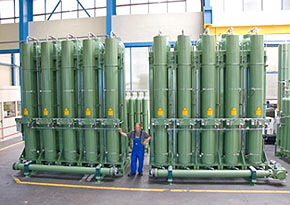Brief Info as Distributed at 2016 Maker Faire
Ultra-Linear
Hydraulic Accumulator
What
is a “Hydraulic Accumulator”? Hydraulic
accumulators have been in use in systems utilizing hydraulic oil to
power equipment for well over one hundred years. It is basically a
reservoir of pressurized oil, integrated
into a hydraulic pump and hydraulic motor system to perform
heavy-duty work (think backhoe, and other earth-moving equipment, as
well as oil drilling/oil platform equipment). The accumulator acts
to smooth the oil pressure in the hydraulic system.
There
are several methods used to pressurize the oil in a hydraulic
accumulator. Most typically, compressed nitrogen gas is used. Note
that springs are used, but all these methods (save the weight loaded
reservoir) have
a problem: power decreases rapidly, if more than 20% of the oil
stored is used.
Here is a link to a file published by hydraulics specialist company Hydac description of high-pressure accumulators that use a bladder:
http://www.hydac.com.au/MessageForceWebsite/Sites/279/Files/E.3.203.3.03.12.pdf
This gives you some insight into what an "accumulator". Here are two pictures of a large array of accumulators, as well as smaller, varied accumulators:

What
do you mean by “Ultra-Linear?” Most
hydraulic accumulators are small in size. My proposed device would
be approximately five feet high, three feet wide, and stretch in a
line (not particularly straight, not particularly level) for a
half-mile, or more.
Why
not use “pumped hydro” reservoirs to store renewable energy?
Unfortunately, constructing two
large reservoirs to contain
the
vast amounts of water needed to make an economic system of energy
storage, is constrained by geography
and geology. Useful sites for pumped storage are almost never near
urban centers demanding significant amounts of power. This hydraulic
system could be located in straight line locations, such as along
metropolitan freeway land.
Why
have no hydraulic accumulators heretofore been used to store energy
from wind, solar, tidal, and other renewables? Note
the drawing above. Most accumulators
use compressed gas, and the
problem with compressed gas is that it heats up, and energy is lost
as the heat dissipates.
There are very few places where compressed gas is used to store
megawatts of electricity. You have to use springs, or a heavy
weight, to avoid Carnot
Efficiency losses.
Even then, a large volume of oil is required, and converting that
oil under pressure to electricity has been not very efficient up
to now.
What
has changed? Are there more efficient hydraulic motors now?
Enter Artemis Intelligent
Power (http://www.artemisip.com/)
By using computer controls, Artemis has achieved 90%+ "Overall Efficiency" (blue line) in converting pressurized oil to rotating power.
Using a rotating generator
offers the best quality power for a wider set of businesses and
homes.
Where
are the springs in your system? I
am using fiberglass springs, which outperform steel springs
over time. The latest
Chevrolet Corvettes use a front fiberglass leaf spring in place of
steel, as it gives better performance (millions
of cycles before replacement)
and weight savings.
Why
use leaf springs? The sheets
of fiberglass, configured as multiple sheets, give a more constant
spring rate if designed correctly. The fiberglass sheet also functions as an
enclosure, protecting against weather, as well as performing to store energy.
What
about individual battery power in homes? (e.g., Tesla Home Battery)
It should prove 25% cheaper to
use this “Ultra-Linear” grid-scale system, powering four to five
hundred homes for eight hours, than installing individual battery systems in every
individual household. The
Independent
System
Operator
that distributes utility electricity throughout California
could better utilize solar power plants and wind turbine farms if larger entities were
consistently available to absorb excessive renewables generation.
System
Build Comparison Building
lithium batteries requires specialized employees, and high engineering costs, as does the
construction of Pumped Hydro facilities. The Ultra-Linear Hydraulic
Accumulator could be produced anywhere with limited training, and
shipped to urban as well as remote locations (think Western Alaskan
villages) where local residents could be trained to both build the
system as well as maintain its operation.

No comments:
Post a Comment